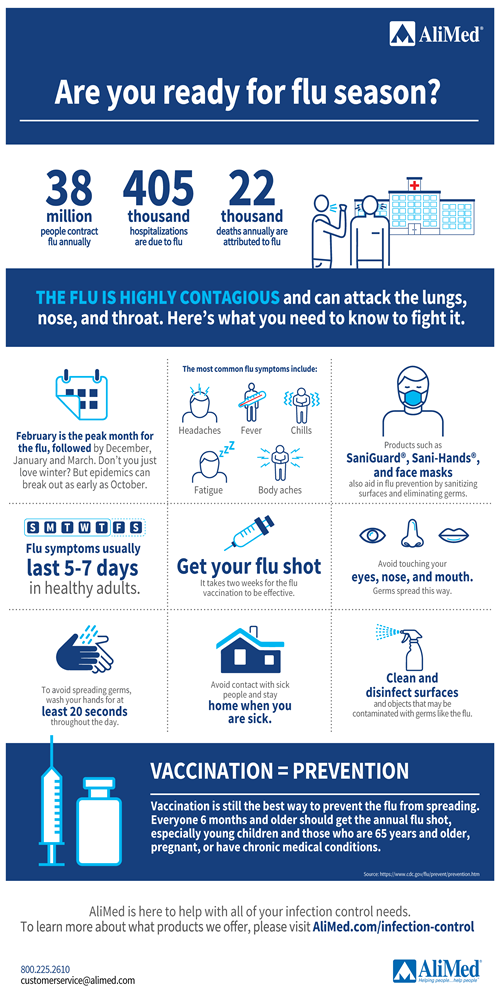-
Home
-
Preparing for Flu Season Amid a Global Pandemic
Preparing for Flu Season Amid a Global Pandemic
December 3, 2020

Download a printable poster here.
When the influenza virus hits the U.S. each year, it hits hard—and this flu season is unprecedented in that it comes alongside a surge in cases of COVID-19 amid a global pandemic.
Reducing the spread and severity of flu’s impact on healthcare is more critical than ever as COVID-19 is draining a significant number of resources on its own and creating a unique, multi-faceted burden on the healthcare system.
While the CDC has not engaged in its traditional FluSight forecasting activity due to the COVID-19 pandemic, there are still lessons to be learned from the 2019-2020 flu season and its strategies that have helped combat the spread of influenza in the U.S. in the past.
A Look Back at the Previous Flu Season
According to the CDC, last year’s flu season was characterized by “two consecutive waves of activity.” Activity began to increase in November, then remained high throughout the latter stages of the flu season in January and February.
The 2019-2020 season was described as “moderate” with its 38 million cases, despite the fact that there were more cases during the 2018-2019 season (estimated at 35.5 million). However, last year’s flu burden was lower than that of the 2017-2018 season, which is estimated to have had nearly 49 million cases and 80,000 deaths.
In addition to the number of overall cases, the CDC estimates for the 2019-2020 flu season included 18 million visits to a healthcare provider, 405,000 hospitalizations, 22,000 deaths, and an unusual overall severity for children younger than 4 and adults 18-49 years old, “where rates of infections, medically attended illnesses, hospitalizations, and deaths were higher than those observed during the 2017-2018 season.”
On top of a global pandemic, numbers like these can immediately impact already-overwhelmed healthcare staff, reinforcing the need for all populations to take appropriate measures to protect themselves and others from flu and other potential viral infections.
Flu Facts and Symptoms
February is the height of flu season, followed by December, January, and March. However, there have been outbreaks as early as October. Anyone can catch flu, and most healthy adults have symptoms that can last five to seven days.
The most common flu symptoms include headaches, fever, chills, fatigue, and body aches. These symptoms should be a signal to stay home to rest and not run the risk of infecting others. While this is an important prevention tip, it is possible to contract flu if you’ve been exposed to someone who has been infected 24 hours before their symptoms set in, and 24 hours after their fever breaks.
According to the CDC, the flu virus is spread mainly by tiny droplets that are dispersed by coughs, sneezes, and talking. Flu not only spreads from person to person but also from touching a surface on which the tiny droplets may have landed.
Therefore, it is important to sanitize the entire environment where healthcare services are provided, including walls and ceilings. SaniGuard® Total Release sanitizes an entire room—walls, ceiling, and floor—in just 15 minutes.
Argument for Mandatory Flu Shots
Concern for the health of patients has prompted many hospitals to require all of their employees to get flu shots or lose their jobs. But what about the rights of patients, in this case doctors and nurses, to refuse any medical procedure they feel is unnecessary? There are arguments hospitals set forth as justification for requiring their staff to get flu shots.
- Patient safety: Hospitals don’t want their patients to contract flu from the doctors and nurses who treat them.
- Staff at increased risk: Healthcare professionals are at an increased risk for contracting flu since they are around sick people. Keeping staff healthy can also protect your facility's bottom line since doctors and nurses who get flu use more sick days than those who don’t.
Simple Measures to Help Prevent the Spread of Flu
According to the CDC, vaccination is the best solution to prevent flu. In addition to the vaccine, there are simple measures that can be taken to help prevent the spread of flu and other viruses, including COVID-19:
- Cover the mouth and nose when coughing or sneezing
- Wash your hands with antimicrobial soap for at least 20 seconds throughout the day
- Avoid touching your eyes, nose, and mouth
- Avoid contact with sick people
- Stay home 24 hours after your fever is gone except to get medical care
- Use hand sanitizer when soap and water are not available
- Wear masks and gloves to help prevent the spread of germs
- Clean and disinfect surfaces contaminated with germs with products such as SaniGuard® Surface Spray or sanitizing wipes
Taking everyday precautions is step one in the ongoing fight against flu, COVID-19, and other viruses, but facilities must stay vigilant and be prepared to combat not only today's infectious diseases, but whatever comes next. With AliMed's ever-growing line of Infection Control products from room disinfectants and sanitizers to a full assortment of PPE, we can help you and your facility stave off the risk of infection while protecting patients and staff.
You may also be interested in: